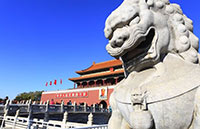Strategy needed to balance population structure
Updated: 2015-11-11 08:03
By Mu Guangzong(China Daily)
|
||||||||
Besides, women generally believe it is best to not have children after 35 years of age. Sow omen born in the 1970s had a limited period to have a second child after the easing of the family planning policy in 2013.
The two-child policy is a welcome change, for instead of "controlling" the second child, it "encourages" couples to have two children. But since most Chinese families want no more than two children, the change in the family planning policy can hardly help emerge out of the "low fertility trap". It can ensure social equality and reduce social risks, though, by reducing the high gender imbalance in the country. It can also help the country cope with the problems of an aging society and a shrinking working-age population.
It's difficult to solve all of China's population-related problems. Hence, our population development and management mechanisms should be balanced and systematic, as well as move with the times.
A very low fertility rate will lead to an unbalanced population structure. The ratio of children (from 0 to 14 years) in the total population is declining while that of senior citizens is increasing. This is a worrying sign, because it is today's children that will make tomorrow's China more creative, competitive and dynamic.
An unbalanced population structure will impede China's sustainable development and complicate social issues such problems related to an aging society. But many people believe China still has a very large population. The need, therefore, is for the central and local authorities to develop a new understanding about population issues rather than focusing only on how to implement the new family planning policy.
Allowing all couples to have two children, however, is only a transitional policy, and a sound population planning demands a long-term population development strategy.
The author is a professor at the Population Research Institute of Peking University.
- Beijing expected to implement two-child policy in 2016
- Two-child policy to increase potential economic growth rate
- Two-child policy needs support
- Official: two-child policy will be implemented after revised laws come into force
- Two-child policy to balance demographics
- Sectors that could benefit from the two-child policy
- Two-child policy won't lead to a baby boom
- Global health entering new era: WHO chief
- Brazil's planning minister steps aside after recordings revelation
- Vietnam, US adopt joint statement on advancing comprehensive partnership
- European border closures 'inhumane': UN refugee agency
- Japan's foreign minister calls A-bombings extremely regrettable
- Fukushima impact unprecedented for oceans: US expert

 Stars of Lijiang River: Elderly brothers with white beards
Stars of Lijiang River: Elderly brothers with white beards
 Wealthy Chinese children paying money to learn British manners
Wealthy Chinese children paying money to learn British manners
 Military-style wedding: Fighter jets, grooms in dashing uniforms
Military-style wedding: Fighter jets, grooms in dashing uniforms
 Striking photos around the world: May 16 - May 22
Striking photos around the world: May 16 - May 22
 Robots help elderly in nursing home in east China
Robots help elderly in nursing home in east China
 Hanging in the air: Chongqing holds rescue drill
Hanging in the air: Chongqing holds rescue drill
 2.1-ton tofu finishes in two hours in central China
2.1-ton tofu finishes in two hours in central China
 Six things you may not know about Grain Buds
Six things you may not know about Grain Buds
Most Viewed
Editor's Picks

|

|

|

|

|

|
Today's Top News
Liang avoids jail in shooting death
China's finance minister addresses ratings downgrade
Duke alumni visit Chinese Embassy
Marriott unlikely to top Anbang offer for Starwood: Observers
Chinese biopharma debuts on Nasdaq
What ends Jeb Bush's White House hopes
Investigation for Nicolas's campaign
Will US-ASEAN meeting be good for region?
US Weekly

|

|









